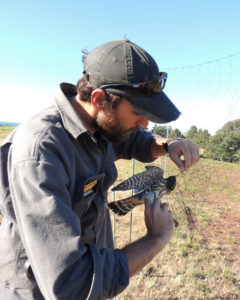Senior Wildlife Biologist

Chris removes a Merlin from a mist net.
Chris Persico, B.S.
Senior Wildlife Biologist
chris.persico@briwildlife.org
207-839-7600 x173
Chris began working for BRI as a seasonal field biologist assisting with Bald Eagle nestling sampling in Maine. He was hired full-time in 2013 and is now one of BRI’s senior level field biologists.
Chris is highly skilled in wildlife capture, including: Common Loons, Bald Eagles, breeding Peregrine Falcons, bats, and migrating raptors (e.g., using bal-chatri, dho-gazza, and mist nets). With this expertise, Chris trains internal staff on capture, sampling, surveying, and banding techniques. He oversees field projects that specialize in short and long-term tracking, including the use of satellite and GPS technology. With his back-country medical and rescue skills, he is the lead field biologist overseeing operations for BRI’s western loon demographic and contaminant monitoring.
Education & Certifications
- B.S., Wildlife Ecology, University of Maine, Orono, 2008
Research Interests & Expertise
Research Interests
- Tracking wildlife using satellite transmitters
- Identifying potential toxicological threats to wildlife
- Raptor conservation
Expertise and Experience
- Capturing nestling Bald Eagles – tree climbing
- Capturing migrating raptors
- Capturing Common Loons using night-lighting techniques
- Banding and sampling raptors and loons
Research Reports


